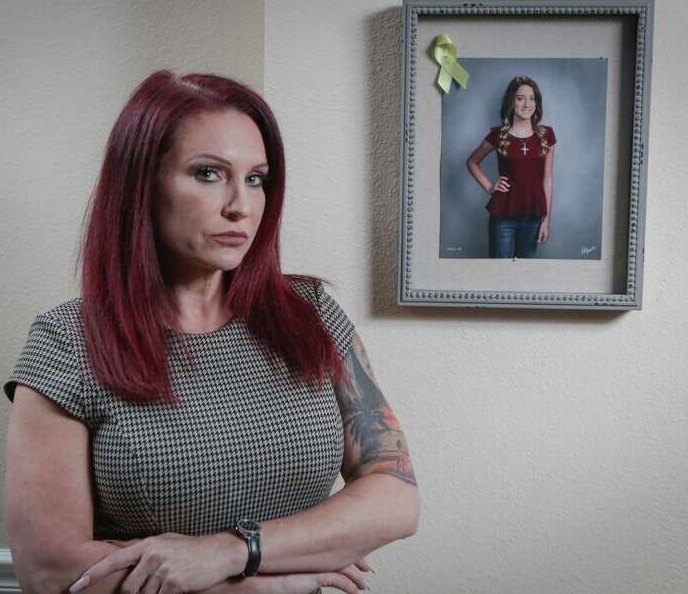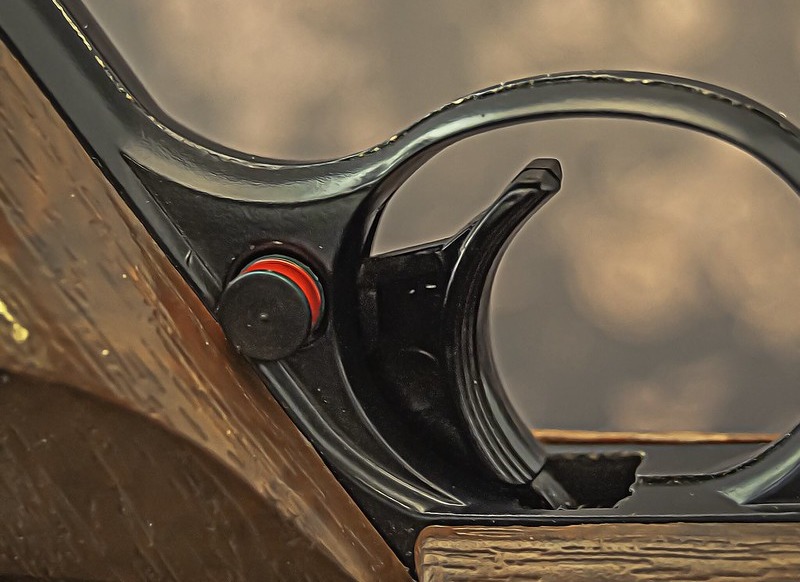After running toward the sound of a gunshot that still haunts her, Marentha Sargent watched her 14-year-old, Adrienne Lambert, bleeding from the chest as she collapsed.
Moments earlier, the 14-year-old son of Gene Roessler, Sargent’s friend, had ejected the magazine from Roessler’s gun, pointed its barrel at Adrienne and pulled the trigger. The boy didn’t realize, according to police records, there was a bullet in the chamber of his father’s handgun, which he’d grabbed from the kitchen table of their suburban Houston home while the adults were in the garage watching football on TV.
“I saw her eyes. I could just tell that the life had left her body,” Sargent said, of that December 2017 tragedy. “I use the word accident. I really don’t know how to categorize it. He pointed the gun at her and pulled the trigger — so, technically, it wasn’t an accident.”
Adrienne died before she reached the hospital.
For leaving his loaded gun out in the open and accessible, the teenage shooter’s father, a friend of Sargent’s since their schooldays, was sentenced to 30 days of incarceration and, after that, two years of probation. He and his wife were fined $4,000 and court-ordered to serve 300 hours of community service. Their teenager, who was not identified because he was a minor, was sentenced to four years in the Harris County Juvenile Detention Center.

Marentha Sargent stands next to a photograph of her daughter.
For her part, Sargent has sought to turn the agony of that day into activism, launching Gun Safety 4 Adrienne Lambert on Facebook to teach gun owners about the necessity of safely storing firearms, even as laws in some states, especially southern ones, do not mandate such storage.
Born and reared among hunters, sport shooters and other gun owners, Sargent has been working to persuade parents to steep their children in gun safety and knowledge about the dangers guns can pose. Those efforts started in Sargent’s own home. With that grieving mother’s encouragement, her partner — news reports say he caught Adrienne’s body as it was falling to the kitchen floor — purchased a car console safe and a nightstand safe after Adrienne was killed.
“I never thought that I would lose my child to gun violence,” Sargent told the Juvenile Justice Information Exchange.
Her self-styled campaign for safe storage of guns comes amid a spike in the number of youth who accidental shoot themselves or someone else. The shortcomings of existing laws regarding safe storage, researchers told JJIE, are reflected, according to Everytown for Gun Safety, in 392 unintentional shootings by persons under the age of 18 in 2021, resulting in 163 deaths and 248 injuries during 2021. That compared to 368 unintentional shootings, resulting in 141 deaths and 242 injuries in 2020; and 305 unintentional shootings, 117 deaths and 202 injuries in 2019. So far in 2022, there have been at least 101 unintentional shootings involving that age group, resulting in 46 deaths and 66 injuries.
In each of those years, most of the shootings were in southern states: 64 — or 64% — of 101 shootings in 2022; 207 — or 53% — of 392 in 2021; 188 — 51% — of 368 in 2020.
Southern gun owners account for most of what the 2021 “National Firearms Survey” counts as more than 393 million civilian-owned firearms. That equated to 120 firearms for every 100 citizens, according to the survey, which was conducted by researchers from Georgetown University McDonough School of Business.
Separately, Pew Research Center concluded back in 2017 that a majority of those firearms were handguns. And a study published in 2018 in the American Journal of Public Health — before a surge in firearms purchases during the pandemic, when a historic number of children were home, learning remotely — estimated that 54% of gun owners do not secure their weapons.
Last year, there was a more than fourfold increase in the number of children living in households where firearms were present: 30 million in 2021 versus seven million in 2015, concluded a paper published in February 2022 in the Journal of the American Medical Association Pediatrics. Of those children, 4.6 million live around one unlocked and loaded firearm, the researchers from Northeastern and Harvard Universities wrote.
And, overall, in recent years, roughly 40% of unintentional shooting deaths among children between the ages of 11 and 14 occurred in the home of a friend where guns were not safely stored, according to Nationwide Children’s Hospital.
“Many people say that they’re buying a gun for self-defense and it ends up not working that way,” said Sarah Burd Sharps, senior director of research at Everytown for Gun Safety. “Those tragedies are all too common. What we’re trying to do is just to make people aware of both the risks of bringing a gun into the home and the responsibilities of storing it securely.”
“It’s an epidemic,” Marc A. Zimmerman, co-director of the University of Michigan Institute for Firearm Injury Prevention, said of accidental shootings by unstored guns.“We need to deal with this in the United States.”
Patchwork of laws on child access to guns
That epidemic has claimed, among other examples, an Altamonte Springs, Fla., mom who, while on a Zoom call, was shot dead last October by her 2-year-old. He’d found a firearm in his Paw Patrol backpack. The toddler’s 22-year-old father, the gun’s owner, was charged with manslaughter. In another extreme example of a child’s lethal access to a weapon, a 4-year-old in New Orleans accidentally shot and killed himself with a gun he found in the backseat of a car while his mother smoked marijuana in the front seat.

Sarah Burd Sharps
Human carelessness and error factor into some accidental shootings. But, critics argue, the rise in unintentional shootings involving youth also can be attributed to a patchwork of state laws regarding youth access to firearms. The most protective ones require gun owners to secure firearms whenever they’re not in their immediate possession or control. Safe storage includes lockboxes and safes, but also locks that prevent the trigger from being pulled or the gun from being be loaded.
According to a summary on the website of the Giffords Law Center to Prevent Gun Violence, 32 states have enacted child access prevention laws that, to varying degrees, hold liable the person who failed to properly store a weapon. Ten of those states are in the South: Delaware, Florida, Georgia, Kentucky, Maryland, Mississippi, North Carolina, Oklahoma, Tennessee and Texas.
Of 13 states that “prohibit persons from intentionally, knowingly, and/or recklessly providing some or all firearms to children,” seven were in the South: Delaware, Georgia, Kentucky, Mississippi, Oklahoma, Tennessee and Virginia. Of six states that made it crime for a child to get access to a gun, regardless of whether that access resulted in injury, two were in the South: Maryland and Texas.

Marc A. Zimmerman
Further, according to Giffords website: “There are no [child access prevention] laws at the federal level, and federal law does not generally require gun owners to safely store their guns. Federal law does, however, make it unlawful for any licensed importer, manufacturer or dealer to sell or transfer any handgun unless the transferee is provided with a ‘secure gun storage or safety device … ‘”
Continued Giffords: “The strongest laws impose criminal liability when a minor is likely to gain access to a negligently stored firearm regardless of whether the minor actually gains access (California). The weakest merely prohibit certain persons, such as parents or guardians, from directly providing a firearm to a minor (Georgia).”
In between what Giffords calls a wide range of laws are stronger ones that “impose criminal liability for negligently stored firearms, but only where the child uses the firearm and causes death or serious injury … ” and weaker ones imposing “penalties only in the event of reckless, knowing or intentional conduct by the adult … [L]aws also differ on the definition of ‘minor.’”
Federal pilot project on childhood gun safety
The CDC’s forthcoming interactive ShootSafe website, developed by the University of Alabama at Birmingham, is slated for release in 2023. Targeting those under 15, the site will aim to provide “a theory-based program to teach children firearms safety in an accessible, engaging and educational manner.”

David Schwebel
In March, the university’s Youth Safety Lab launched a clinical trial that researchers say is designed to measure three things: Children’s savvy at hunting, shooting and using firearms safely. Children’s honed skills at impulse control and hypothetical thinking about safely using firearms. Children’s sense of their “vulnerability and susceptibility to firearms-related injuries, the severity of those injuries, and their perceived norms about peer behavior surrounding firearms use.”
“Once children reach about age ten, which is the youngest age we are including in our study, we believe children might be able to learn to be safe with guns,” said psychologist David Schwebel, the lab’s director. “But this isn’t automatic. It requires substantial guidance and effort, and children should still be supervised carefully until they show they can be safe. For those who do choose to keep guns in their homes, safe storage is absolutely essential.”
So far, 10 children, aged 10 through 12, have been enrolled in the trial, which aims to enroll more than 160 and includes a separate analysis of childhood nutrition.
“Easy access” is a concern
Safe storage laws are a kind of low-hanging fruit, say advocates. But safe storage efforts can be overshadowed by calls for more restrictive gun control measures, especially in the wake of high profile mass shootings and other crimes covered by national media. At the same time, some states are eliminating weapons purchasing restrictions such as background checks and gun permits.
Some observers say lowering accidental shootings and making guns less available go hand in hand.
“The easy access to guns is one of the biggest issues,” said Marissa Edmund, senior policy analyst for Gun Violence Prevention at the Center for American Progress.
Of the more than 30 states allowing owners to openly carry handguns in public without a license, a majority are in the South. Of the 10 states requiring a permit to openly carry a handgun, two are in the South. Of the five states that, according to Giffords Law Center, ban open carry of handguns, one is in the South: Florida. There, Republican Gov. Ron DeSantis has joined the list of state leaders pushing to end that ban.

Marissa Edmund
In April, Georgia became the latest state to enact a measure allowing anyone who isn’t legally barred from having a gun to obtain a firearm, without a permit, and to carry it in public. As examples, neighboring Tennessee requires a permit to openly carry a handgun; Alabama restricts guns on private property; Texas requires a valid handgun license and permits a carrier to display in public on a belt holster; and Virginia restricts open-carriers in populous cities.
Meanwhile, legislators in Delaware, where Democratic Gov. John Carney last year signed two gun control measures into law, are considering a proposal requiring prospective gun owners to have a valid license to own a firearm before ever purchasing one.
In addition to government regulation of safe storage, firearms manufacturers have begun integrating technology aimed at preventing misuse. High-tech gun makers like Armatix, LodeStar Works, SmartGunz and Biofire are producing “smart guns,” firearms with palm readers and radio frequency chips or fingerprint readers like those found on smartphones. That could prevent unauthorized use of those weapons, firearms makers contend.
“We want to make sure that firearms do not end up in the hands of people that shouldn’t have them. For example, domestic abusers, or children or another unauthorized user,” said Edmund, of the Center for American Progress.
Some gun owners, however, counter that such technology is fallible and dangerous. It would prevent them from using their weapon quickly in an emergency, they say.
“A traditional firearm is a mechanical device you can count on when you need it,” Erich Pratt, the senior vice president of Gun Owners of America, wrote in an essay for RealClearPolicy.com. “As all Second Amendment advocates, concerned citizens, and law enforcement officers understand, when you are in a self-defense situation, you need a self-defense tool that is simple and reliable enough to work — every single time.”
Sargent, a Second Amendment proponent, hopes that fewer tragedies like the one that befell her daughter will result from the focus on gun use, storage and so forth. As she spreads the word about gun safety and storage to her gun owner friends, families in her communities and other ones, she hopes that her story will hold sway.
“It’s a lot easier,” she said, regarding many of her neighbors, “to hear from someone who has walked in your shoes.”
***
Kenneth R. Rosen has written for, among others, The New Yorker, The New York Times Magazine, The Atlantic and VQR.
































